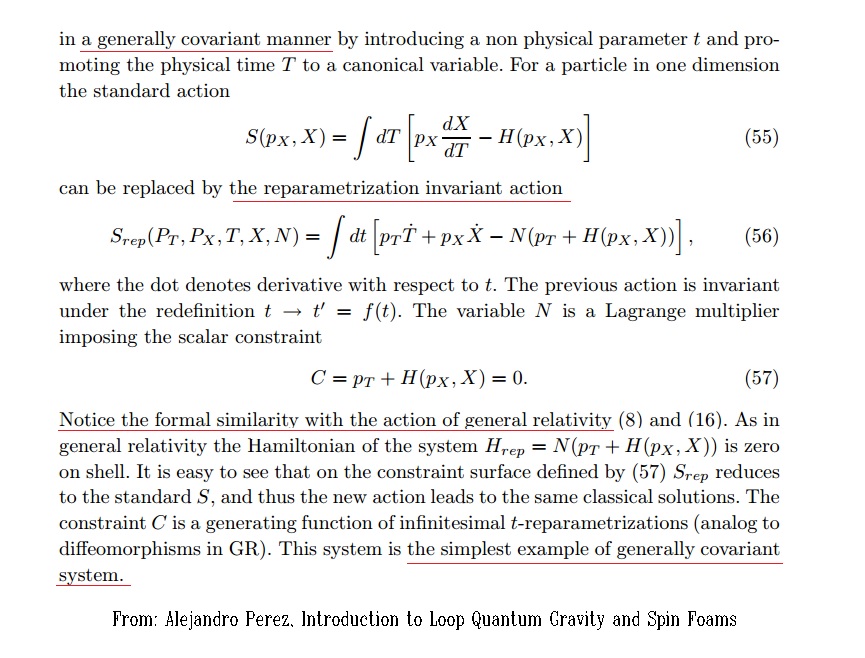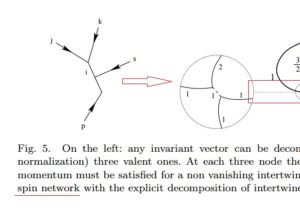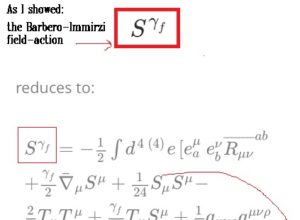Why the need for the Barbero-Immirzi field? Let me briefly explain. We saw that LQG in the Holst formulation faces the serious problem that unless the Barbero-Immirzi parameter is promoted to a field, the three-dimensional action with the Barbero-Immirzi parameter:
![Rendered by QuickLaTeX.com \[\begin{array}{l}S\left[ {e,x,\omega } \right] = {\int_{{M_3}} {\rm{d}} ^3}x{\varepsilon ^{\mu \nu \rho }}\left( {\frac{1}{2}} \right.{\varepsilon _{IJKL}}\\{x^I}e_\mu ^JF_{\nu \rho }^{KL}\left. { + \frac{1}{\gamma }{x^I}e_\mu ^J{F_{\nu \rho }}_{IJ}} \right)\end{array}\]](https://www.georgeshiber.com/wp-content/ql-cache/quicklatex.com-020d8d6de81e54e561046e0ba4e01c91_l3.png)
cannot admit a 4-D uplifting of the reduced 3-D gauge-free spacetime compactified action:
![Rendered by QuickLaTeX.com \[\begin{array}{*{20}{l}}{{S^{{\rm{Red}}}} = - \int_{{S^1}} {\rm{d}} {x^3}\int_{{M_3}} {{{\rm{d}}^3}} x{\varepsilon ^{\mu \nu \rho }}\left( {\frac{1}{2}} \right.}\\{{\varepsilon _{IJKL}}e_3^Ie_\mu ^JF_{\nu \rho }^{KL}\left. { + \frac{1}{\gamma }e_3^Ie_\mu ^J{F_{\nu \rho }}_{IJ}} \right)}\end{array}\]](https://www.georgeshiber.com/wp-content/ql-cache/quicklatex.com-22ad282a8a1c8fd7106ab508fa90f4be_l3.png)
to the 4-D Holst-action:
![Rendered by QuickLaTeX.com \[\begin{array}{*{20}{l}}{{S_{4D}}\left[ {e,\omega } \right] = \int_{{{\tilde M}_4}} {{{\rm{d}}^4}} x{\varepsilon ^{\mu \nu \rho \sigma }}\left( {\frac{1}{2}} \right.{\varepsilon _{IJKL}}}\\{e_\mu ^Ie_\nu ^JF_{\rho \sigma }^{KL}\left. { + \frac{1}{\gamma }e_\mu ^Ie_\nu ^J{F_{\rho \sigma }}_{IJ}} \right)}\end{array}\]](https://www.georgeshiber.com/wp-content/ql-cache/quicklatex.com-5259c49f9f6455fd1438a77ef93a80e4_l3.png)
and that is because the total 3-D action with the Barbero-Immirzi parameter:
![Rendered by QuickLaTeX.com \[\begin{array}{l}S\left[ {e,x,\omega } \right] = {\int_{{M_3}} {\rm{d}} ^3}x{\varepsilon ^{\mu \nu \rho }}\left( {\frac{1}{2}} \right.{\varepsilon _{IJKL}}\\{x^I}e_\mu ^JF_{\nu \rho }^{KL}\left. { + \frac{1}{\gamma }{x^I}e_\mu ^J{F_{\nu \rho }}_{IJ}} \right)\end{array}\]](https://www.georgeshiber.com/wp-content/ql-cache/quicklatex.com-020d8d6de81e54e561046e0ba4e01c91_l3.png)
is invariant under rescaling symmetry and translational symmetry, which destroy the time-gauge accessibility of the theory and 4-D-uplifting. Let us see whether and how promoting the Barbero-Immirzi parameter to a field and using the Nieh–Yan topological invariant can ameliorate our crises. In Lagrangian Holst theory, a Hilbert–Palatini action can always be generalized to contain the Holst term and promotes the Barbero–Immirzi parameter to a field via:
![Rendered by QuickLaTeX.com \[\begin{array}{l}{S^{{\gamma _f}}} = \int_{{M_4}} {dtL = - \frac{1}{2}} \int_{{M_4}} {{d^4}} x{\,^{(4)}}e\\e_a^\mu e_b^\nu {\left( {{R^{ab}}} \right._{\mu \nu }} - \frac{{{\gamma _f}}}{2}{\varepsilon ^{ab}}_{cd}\left. {{R^{cd}}_{\mu \nu }} \right)\end{array}\]](https://www.georgeshiber.com/wp-content/ql-cache/quicklatex.com-59b5d0b830e8a577298b97a6e4e24b0c_l3.png)
with:
![]()
the determinant of the LQG-tetrad, and:
![]()
being the Riemannian curvature corresponding to:
![]()
Clearly,
![]()
is not equivalent to a Hilbert-Palatini action, since the first Cartan equation is affected by the BI-field: a torsion trace contributes depending on the derivative of the BI-field. Letting
![]()
be the covariant Lorentz spin-valued connection-derivative, with spin-connection
![]()
and
![]()
the torsion tensor.
The Bianchi cyclic equation is then:
![]()
and so the Holst term does not vanish, thus
![]()
is a constant.
Now, given the trace vector:
![]()
and the identity:
![]()
it follows that:
![]()
reduces to:
![Rendered by QuickLaTeX.com \[\begin{array}{l}{S^{{\gamma _f}}} = - \frac{1}{2}\int {{d^4}{\,^{(4)}}} e\left[ {e_a^\mu } \right.e_b^\nu {\overline {{R_{\mu \nu }}} ^{ab}}\\ + \frac{{{\gamma _f}}}{2}{{\bar \nabla }_\mu }{S^\mu } + \frac{1}{{24}}{S_\mu }{S^\mu } - \\\frac{2}{3}{T_\mu }{T^\mu } + \frac{{{\gamma _f}}}{3}{T_\mu }{S^\mu } + \frac{1}{2}{q_{\mu \nu \rho }}{q^{\mu \nu \rho }}\\ + \frac{{{\gamma _f}}}{2}{\varepsilon _{\mu \nu e\sigma }}{q_\tau }^{\mu \rho }\left. {{q^{\tau \nu \sigma }}} \right]\end{array}\]](https://www.georgeshiber.com/wp-content/ql-cache/quicklatex.com-a0891e7cc9d6ef721f38feba43e319a9_l3.png)
with
![]()
and
![]()
is the torsion-less metric-compatible covariant derivative. By solving,
![]()
induces contortion spin-connections, and hence:
![]()
generalizes to:
![Rendered by QuickLaTeX.com \[\begin{array}{l}S_{NY}^{{\gamma _f}} = - \frac{1}{2}\int {{d^4}} x{\,^{(4)}}e\,e_a^\mu e_b^\nu {R_{\mu \nu }}^{ab} - \\\frac{1}{4}\int {{d^4}} x{\,^{(4)}}e{\gamma _f}\left( {{\eta _{ab}}} \right.T_{\mu \nu }^aT_{\rho \sigma }^a - \\e_a^\mu e_b^\nu \varepsilon _{cd}^{ab}\left. {{R_{\mu \nu }}^{cd}} \right)\end{array}\]](https://www.georgeshiber.com/wp-content/ql-cache/quicklatex.com-bac6613a1aed3dcb673a33761fd10bb3_l3.png)
Thus, the second integral is the Nieh-Yan topological invariant and connects to the Holst term, yielding
![Rendered by QuickLaTeX.com \[\begin{array}{l}^\dagger S_{NY}^{{\gamma _f}} = - \frac{1}{2}\int {{d^4}} x{\,^{(4)}}e\left[ {e_a^\mu } \right.e_b^\nu {\overline {{R_{\mu \nu }}} ^{ab}}\\ + \frac{{{\gamma _f}}}{2}{{\bar \nabla }_\mu }{S^\mu } + \frac{1}{{24}}{S_\mu }{S^\mu } - \frac{1}{3}{T_\mu }{T^\mu }\\ + \frac{1}{2}{q_{\mu \nu \rho }}\left. {{q^{_{\mu \nu \rho }}}} \right]\end{array}\]](https://www.georgeshiber.com/wp-content/ql-cache/quicklatex.com-bc212042223899729c5ef767c74a794d_l3.png)
Now, one varies the action with respect to the irreducible components of:
![Rendered by QuickLaTeX.com \[\left\{ {\begin{array}{*{20}{c}}{{S^\mu }}\\{{T^\nu }}\\{{q^{\rho \sigma \tau }}}\end{array}} \right.\]](https://www.georgeshiber.com/wp-content/ql-cache/quicklatex.com-6450fe597f88ea70d12e55209750b922_l3.png)
to obtain:
![Rendered by QuickLaTeX.com \[\left\{ {\begin{array}{*{20}{c}}{{\partial _\mu }{\gamma _f} - \frac{1}{6} - {S_\mu } = 0}\\{{T_\mu } = 0}\\{{q_{\mu \nu \rho }} = 0}\end{array}} \right.\]](https://www.georgeshiber.com/wp-content/ql-cache/quicklatex.com-96aa77603661984b8a1a282da64647ba_l3.png)
Inserting into:
![]()
one gets the effective action:
![Rendered by QuickLaTeX.com \[\begin{array}{l}S_{eff}^{{\gamma _f}} = - \frac{1}{2}\int {{d^4}} x{\,^{(4)}}ee_a^\mu e_b^\nu {\overline {{R_{\mu \iota }}} ^{ab}} + \\\frac{3}{4}\int {{d^4}} x{\,^{(4)}}e{\partial _\alpha }{\gamma _f}{\partial ^\alpha }{\gamma _f}\end{array}\]](https://www.georgeshiber.com/wp-content/ql-cache/quicklatex.com-2bb46af581f7cc76064db472a2a549b6_l3.png)
giving us an equivalence with the Hilbert-Palatini torsion-free action and thus solving the gauge-free accessibility problem as well as the 4-D uplifting problem caused by invariance under rescaling symmetry and translational symmetry: the proof is straightforward.
- Since the phase-space has symplectic structure:
![]()
and
![]()
It thus follows that the total BI-field Hamiltonian:
![]()
with
![]()
the Lagrange multipliers, obeys:
![]()
where
![]()
is the Poisson bracket satisfying:
![Rendered by QuickLaTeX.com \[\begin{array}{l}\left\{ {E_i^a\left( x \right),A_b^i\left( x \right)} \right\} = \delta _b^a\delta _j^i\left( {x,y} \right) = \\\left\{ {\pi _i^\alpha \left( x \right),\omega _b^{(3)i}\left( y \right)} \right\}\end{array}\]](https://www.georgeshiber.com/wp-content/ql-cache/quicklatex.com-3f2a1426edc031495e3d3fb0aed0152f_l3.png)
with
![]()
being the time-evolution of the BI-field and
![]()
an arbitrary field. Q.E.D



